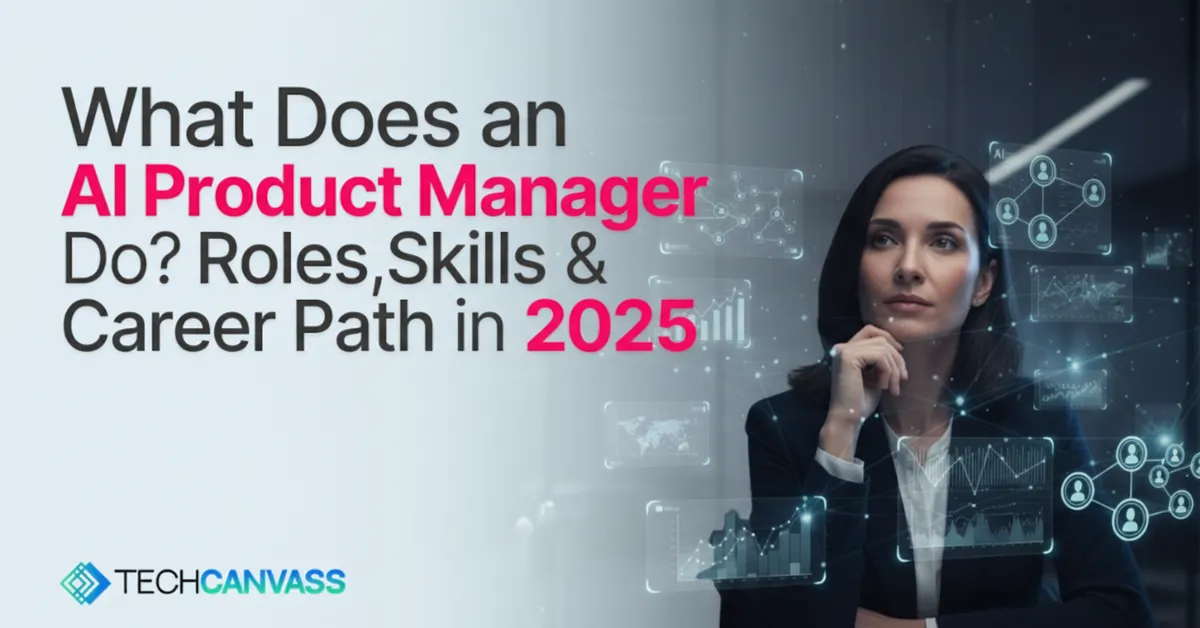Last Updated on November 4, 2025 by Techcanvass Academy
Table of Contents
Overview
Let me start with a real story. In 2015, Netflix had a problem. They had millions of movies and shows, but how do you help a customer find what they want to watch?
Think about it. When you open Netflix, you see different shows than your friend sees. Netflix shows you different pictures of the same show depending on what you might like. They show some people a picture of action scenes. They show others a picture of dramatic moments. Why? Because they know what gets you excited.
Netflix’s product team figured out something simple but powerful: if they show each of their 220 million customers different pictures of the same movie, more people will click and watch. Sometimes this difference means 5% of people click. Sometimes it means a 10% click. That extra 5% sounds small, but it represents millions of people watching more content.
This is what an AI Product Manager does. They don’t just say “build a system.” They think about how that system will change user behaviour, how to measure success, what can go wrong, and how to make it work for millions of different people.
Today, Netflix spends about $1 million every year to keep this recommendation system running. And it’s responsible for 80% of what people watch on the platform. That’s an incredible return on investment.
An AI Product Manager doesn’t just build features — they design intelligent systems that influence human behaviour at scale, measure impact, and continuously learn to drive business results.
Useful Links
What Makes This Job Different From Regular Product Management?
A regular product manager might say: “If we add this feature, customers will do this action.” They plan everything step by step. Build it. Ship it. Watch it work the same way for everyone.
An AI Product Manager thinks differently. They think about probability. They think about uncertainty. They think about systems that change and learn.
Let me explain with another real example: PayPal’s fraud detection system.
PayPal protects money moving across the internet. They need to stop criminals from stealing credit card information. But they also need to let good customers buy things quickly without problems.
In 2018, PayPal’s fraud system had a problem. It was too cautious. Whenever the system thought a transaction might be fraud, it stopped it. Then someone had to manually review it. This review took hours sometimes. Real customers got frustrated because their payments got blocked. Many switched to other payment services like Stripe.
PayPal’s product team couldn’t just make the system less careful, because then criminals would steal more money.
So what did they do? They stopped thinking in black and white. They started thinking in shades of grey.
Instead of saying “fraud” or “not fraud,” the system now gives each transaction a risk score. It looks at dozens of pieces of information: Where are you? What device are you using? What time of day is it? How much money is it? Have you bought from this place before?
How AI Handles Risk-Based Decisions
- Low-risk transactions get approved instantly.
- Slightly suspicious transactions are flagged for fast manual review.
- Very high-risk transactions are blocked automatically to prevent fraud.
Results? Regular transactions go through immediately. Fraud goes down. Customers are happy. This is what AI Product Managers create: systems that handle uncertainty instead of pretending it doesn’t exist.
Real Company Example: Starbucks Deep Brew
Let me tell you about Starbucks’ Deep Brew system because it shows what AI Product Managers do every single day.
Starbucks asked themselves: How can we make each customer feel like we know them personally—even though we have millions of customers?
The Deep Brew system looks at five types of information about each customer:
- What they ordered before – If you bought iced lattes 50 times
- When they visit – If you come every morning at 8 AM
- Where they are – If you’re at the Starbucks near your office
- The weather – If it’s hot outside
- What day it is – If it’s a weekday or weekend
Here’s the clever part. The system doesn’t just memorize what you always get. It thinks. It learns patterns.
If you always order iced lattes when it’s hot, but today it’s cold and rainy, the system might suggest a hot cappuccino instead. This feels personal. It feels like a real person understands you.
What Did the Product Manager Do Right?
- First, they asked the right question. Not “how do we recommend more products” but “how do we make people feel known.”
- Second, they made a trade-off decision. They didn’t try to be 100% accurate. They chose to be 85% accurate if that made the recommendation feel more surprising and personal.
- Third, they measured success differently. They didn’t just count “how many recommendations did people accept.” They looked at bigger things like “are Rewards members coming back more often” and “are they spending more money.”
The result? Starbucks has 34.3 million active Rewards members in the United States alone. Personalized recommendations drive way more engagement than generic ones.
What Do AI Product Managers Actually Do Every Day?
Let me break down the six main jobs of an AI Product Manager:
1. Figuring Out What Problems AI Can Solve
Not every problem needs AI. This is the most important thing to understand.
Amazon’s story teaches this lesson. Amazon didn’t say “let’s use AI to recommend everything.” Instead, they noticed something deeper about shopping.
When you look at a tent on Amazon, you’re probably planning a camping trip. You’re not just shopping for one thing. You’re looking for everything for a camping trip.
Amazon’s product team realized they could look at what customers were reading. If you were reading reviews about hiking boots, the system could guess you needed outdoor gear. Then it could recommend tents, sleeping bags, backpacks—things that fit your trip, not just random stuff.
This is “intent mining.” Understanding what the customer really wants, not just what they bought last time.
Amazon’s recommendation engine now drives 35% of the company’s yearly revenue. In the first three months of 2024, that was about $50 billion in sales influenced by their AI. The product manager’s job was seeing that opportunity and building it.
2. Making Decisions About Mistakes
Here’s something most people don’t think about: AI systems make mistakes. Always.
A doctor in London named DeepMind built an AI system to read eye scans. The system was 94% accurate. That sounds great. But what about the 6% where it’s wrong?
The real problem: Eye problems like diabetic retinopathy can cause permanent blindness if not treated quickly. If the AI misses one of these cases, a patient loses their sight.
 So the product manager at DeepMind had to ask hard questions:
So the product manager at DeepMind had to ask hard questions:
- When should we trust the AI to make a decision alone?
- When should we make a doctor review it?
- For serious conditions that get worse fast, should we be more careful?
 The answers became rules:
The answers became rules:
- If we’re less than 85% confident, a doctor reviews it
- For serious conditions, we use more careful thresholds
- For slow-moving problems, we can be a bit more aggressive
Result? The system now reviews thousands of eyes per week. Patients who would lose their sight get treatment before permanent damage happens. Waiting times drop dramatically.
The product manager didn’t just ask “is the AI accurate enough?” They asked “what happens when the AI is wrong, and how do we handle that?”
3. Making Sure You Have Good Data
Here’s a hard truth: A perfect AI system with bad data doesn’t work. The data quality decides whether the whole thing works or fails.
Coca-Cola wanted to personalize advertisements around the world. But Coca-Cola does business in 200+ countries. People in India want different things than people in Sweden. People in cities want different things than people in farms.
 The product team at Coca-Cola had to check their data carefully:
The product team at Coca-Cola had to check their data carefully:
- Is the data from everywhere or just from cities?
- Do we have information from rich people and poor people?
- Are we seeing patterns from men, women, and different ages?
- Do different countries have different patterns?
 They did three things:
They did three things:
- Checked all their data sources to make sure they included everyone
- Made sure the training happened fairly for all groups
- Tested regularly: Does the system work equally well for everyone?
The result? Their personalized ads became smarter. They showed soda ads to teenagers at times they were most likely to want a drink. They didn’t waste money showing coffee ads at 2 AM to people who would never drink it.
4. Deciding How to Measure Success
This seems simple, but it’s not. Let me explain with Netflix again.
Netflix could count success the basic way: “Did people click on the recommendation?” But that’s not enough.
 Netflix also tracks:
Netflix also tracks:
- Do recommendations go bad over time? (This is called “model drift”)
- Is the system recommending only the same popular shows or showing variety?
- How good is the system at recommending to brand new users who just joined?
- Which pictures of shows make people click most often?
Here’s something Netflix learned that’s important: If the system only recommends The Office and Friends to everyone, more people watch (short term). But then they get bored and cancel their subscription (long term).
So Netflix deliberately chose to be less accurate in the short term to get better long-term results. They recommend more variety, even if it means fewer people click immediately, because more people stay customers longer.
The product manager’s job was seeing this trade-off and making it happen.
Useful Links
5. Building Systems That Keep Learning
AI products don’t ship and stay the same. They need to keep improving.
Siemens uses AI to watch factory equipment. Sensors on machines measure temperature, vibration, and pressure all day and night. The AI learns to predict when machines will break down before it happens.
But here’s the challenge: As Siemens collects data from thousands of sensors at hundreds of factories, new patterns emerge. Equipment acts differently in different climates. Equipment ages differently in different countries.
 The product team designed it to keep learning:
The product team designed it to keep learning:
- Retrain the system regularly as more data comes in
- Test new versions on a small group of factories first
- Watch if performance gets worse over time
- Quickly go back to the old version if something doesn’t work
The results? Siemens cut unscheduled shutdowns by 25%. That saved them about $750 million every year in prevented lost work time.
6. Making Sure the System is Fair
This is about more than following rules. It’s about building products that don’t hurt people.
Amazon’s recommendation engine looks at past purchase patterns. But past purchase data has biases in it. Maybe the platform historically recommended certain products mainly to certain groups of people. The AI learns this and repeats it.
 Amazon’s product team did several things:
Amazon’s product team did several things:
- Regularly checked if recommendations were different for different groups
- Built fairness rules into the system
- Showed users why things were recommended so they could correct it
- Tested with different groups of real people
This work never ends. Every time they improve the AI, they must check fairness again.
What Skills Do You Need?
You have 8 years as a Business Analyst. You understand data and processes. That’s a great start. Here’s what to add:
Skill 1: Learning to Build Quick Prototypes
You don’t need to be a programmer anymore. Tools exist now that let you build AI-powered things quickly without coding.
- Understanding how to write good prompts to ChatGPT or Claude
- Learning no-code tools like Vercel AI
- Building small projects from idea to working prototype in days
For your spiritual services business, this is practical: How could you use AI to give personal tarot readings? Can you build a quick version using ChatGPT? Test it with real people?
Skill 2: Understanding AI Basics
You need to understand key ideas, not how to build the systems:
- Supervised learning (training on labeled data) vs unsupervised learning
- What it means to “train” a model and then use it
- Why models get worse over time
- The difference between precision (few false alarms) and recall (catching everything)
- What “overfitting” means (when a model works great in training but fails in real use)
Google has free courses on these topics. Spend 10 hours learning and you’ll have more knowledge than 90% of people.
Skill 3: Thinking About Probability
Traditional project management is certain: “If we build this, people will do that.”
AI Product Management is uncertain: “If we deploy this model, 80% of results will be good, 15% will be okay, and 5% will be bad. How do we handle that?”
Practice this way of thinking every day. When you predict something, measure if you were right. Update your thinking based on what actually happened.
Skill 4: Being a Translator Between Groups
You must move easily between three worlds:
- Technical people (data scientists) speak in loss functions and neural networks
- Customers speak in problems and desires
- Business leaders speak in revenue and competition
Your superpower is moving between these groups without losing the meaning.
When a data scientist says “the model has an F1 score of 0.87,” you explain to business leaders: “the system catches 87% of problems while keeping false alarms low enough to be useful.”
Useful Links
What Happens in an Actual Interview?
When you interview for an AI Product Manager job, expect different questions than regular product management jobs.
You might get asked:
Imagine you’re the product manager for a music streaming service. Design an AI feature that increases daily active users by 10%. Walk me through your thinking.
Interviewers are checking for:
- Do you understand what AI can and can’t do?
- Do you think about uncertainty and trade-offs?
- Do you ask smart questions about data and fairness?
- Do you think about user value, not just technical capability?
A strong answer would be:
- Ask clarifying questions first (“Are we trying to get dormant users to come back or recruit new users?”)
- Talk about what data you’d need (“What do we know about user listening patterns?”)
- Describe the AI opportunity (“Could we use collaborative filtering to recommend new artists?”)
- Discuss trade-offs (“Accuracy versus novelty: should we recommend safe choices or surprising ones?”)
- Explain success metrics (“How will we measure whether DAU actually increased?”)
- Address risks (“What if the system recommends music from specific demographic groups more than others?”)
Your Path Forward: A 6-Month Plan
- Months 1-2: Build Foundation Knowledge
Months 1-2: Build Foundation Knowledge
- Week 1-2: Complete Google’s ML Crash Course (about 15 hours)
- Week 3-4: Read “Inspired” by Marty Cagan, take an AI product fundamentals course on Coursera
- Week 5-8: Study how Netflix, Amazon, and ChatGPT actually work
Months 3-4: Get Your Hands Dirty
- Build 2-3 small AI projects using free tools
- Answer questions on Product School forums and Reddit
- Write case studies analyzing how real companies built AI features
Months 5-6: Get Ready for Jobs
- Create a portfolio website showing your AI projects
- Connect with AI Product Managers on LinkedIn
- Practice interview questions
The Bottom Line
In 2025, being a product manager means understanding AI. Companies using AI-skilled product managers are shipping products 40% faster and making smarter decisions than those who aren’t.
The question isn’t whether you should learn AI Product Management. The question is how quickly you can.
You have the foundation. You understand data. You understand business. You have entrepreneurial experience. You just need to deliberately build three things:
- AI literacy (understanding how these systems work)
- Hands-on practice (building real projects)
- Probability thinking (making decisions with uncertainty)
Start this week. Pick one AI product you use. Netflix, ChatGPT, your email spam filter. Use it intensely. Develop theories about how it works. Learn the ideas behind it. Build something.
Useful Links
FAQs
Q. What does an AI Product Manager do?
A. An AI Product Manager identifies where AI can solve real user problems, designs learning systems, and measures performance beyond launch. They balance accuracy, fairness, and business value while shaping intelligent product experiences.
Q. How is an AI Product Manager different from a regular Product Manager?
A. A regular PM works with clear, fixed features, while an AI Product Manager works with uncertainty, probability, and evolving models. Instead of rules, they optimize systems that learn over time.
Q. Do AI Product Managers need to code?
A. No, but they need AI literacy — understanding model basics, data quality, and evaluation metrics. Knowing prompts, no-code tools, and talking effectively with data scientists matters more.
Q. How to become an AI Product Manager?
A. Start by learning AI fundamentals, building small prototypes, and analyzing real AI product case studies. Hands-on practice plus understanding user behavior and data trade-offs accelerates the transition.
Q. What skills are required for an AI Product Manager?
A. Core skills include AI literacy, hands-on experimentation, and probability-based thinking. They must also communicate across technical teams, business leaders, and users.
Q. Do AI Product Managers handle data quality?
A. Yes — they ensure diverse, fair, and representative data inputs because AI systems fail without reliable data. Bias detection and fairness checks are key responsibilities.
Q. How do AI Product Managers measure success?
A. They track accuracy, fairness, long-term user value, and system drift. Success isn’t just clicks — it’s sustained engagement and business impact.



